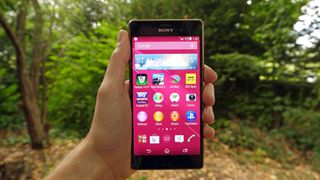
Audio is getting an upgrade. After the convenient but bleary MP3 era, hi-fi has seemingly found its mojo once again, offering better than ever resolution and higher quality streaming options.
High-resolution audio, isn't actually new. Audiophiles have been experimenting with high-resolution music files for years, pimping their laptops and extolling the virtues of Wasapi and ASIO.
Thankfully today's higher resolution music is a mainstream proposition, far removed from such PC chicanery.
Sony has been an early evangelist, launching a range of hardware under its High-Res Audio logo. Much of it has been quite high-end, such as its £2,000 HAP-Z1ES hard drive player and matching TA-A1ES integrated stereo amp.
The tech has also reinvigorated Sony's Android-powered Walkman music players, and has trickled into the Xperia smartphone line. Other brands have been quick to claim similar high-end audio ground.
Bandwidth is booming
"With fast 4G and unlimited data plans, streaming higher quality music services and enjoying high-resolution music on the move is eminently more practical."
With fast 4G and unlimited data plans, streaming higher quality music services and enjoying high-resolution music on the move is eminently more practical.
Get daily insight, inspiration and deals in your inbox
Get the hottest deals available in your inbox plus news, reviews, opinion, analysis and more from the TechRadar team.
But what is high-res audio and why should you care? It's certainly not a standardised file format, codec or wrapper; high-res audio is simply an umbrella term for any audio that's better than 16bit/44.1kHz CD, typically 24-bit 96/192kHz. The bit depth effectively relates to the resolution of the music, while the sampling frequency is indicative of the accuracy of the digital-to-analogue process.
Debate continues to rage in some corners of the internet as to whether 24-bit audio genuinely sounds better than 16-bit, however why this should make anyone's blood boil is a mystery. If you can't hear a difference, keep your money in your pocket and move along. (For the record, 24-bit 192kHz FLAC clearly sounds better than CD if your equipment chain is up to it.)
It's important to note that there are qualitative differences between high-resolution file downloads and the growing number of higher-spec streaming audio services; the former sound significantly better than the latter.
Downloading FLAC
"The real value of hi-res audio downloads for mobile use may well be dictated by your listening habits and not your hardware"
When it comes to file downloads, 24-bit audio can manifest itself in various forms. Studio master recordings encoded in FLAC (Free Lossless Audio Codec) or ALAC (Apple Lossless Audio Codec) offer greater detail and clarity than low bit rate MP3 and AAC, and occupy around half the space of a WAV file. They also have superior metadata support. Device compatibility is high.
The other high-res audio file option is DSD (Direct-Stream Digital). Originally developed for Super Audio CD, DSD 2.8MHz is growing in popularity with audiophiles. Also known as DSD 64, the standard uses a 1-bit/64 times over-sampling process able to achieve 120dB within the 20Hz - 20kHz band.
Device compatibility is somewhat more limited and file sizes are substantial, which makes a DSD library a challenge to store and transport. Perhaps it's just as well that legitimate sources of DSD files are few and far between.
While streaming services are similarly upping their sonic game, none offer the clarity of 24-bit and the potential sonic benefits are more debatable.
No streaming service offers greater than 16-bit resolution, for compatibility reasons. Instead differences manifest themselves in the bitrates used by the various streaming services. iTunes streams at 256kbps, while Spotify offers 320kbps. By way of comparison, newcomer Tidal positively gushes at 1411kbps.
The real value of hi-res audio downloads for mobile use may well be dictated by your listening habits and not your hardware. If you use bog-standard earbuds you won't benefit from the extended frequency range available on hi-res files and if you typically stream music from your mobile to a speaker over Bluetooth, then you'll be limited by the Bluetooth connection itself. Even the Bluetooth aptX codec brickwalls at 352kbps and streams as 16bit/44.1 kHz.
Do you need specialist gear?
If you're primarily going to use a streaming service, then you don't need anything fancy at all. If you're listening on an iPhone 6, Samsung Galaxy family and everything in between, then you're good to go.
Mobile file playback is a different kettle of fish, as file compatibility and ecosystem come into play. The iPhone 6 isn't compatible with high-resolution audio downloads, although this seems to be a firmware related issue rather than component inadequacy. If you have a Samsung Galaxy Note 4, LG G3 or Sony Xperia Z3 you're in 24/192kHz luck.

Alternatively you might want to consider a dedicated audiophile grade player, be it a £549 Sony hi-res audio NWZ-ZX1 Walkman or something altogether more exotic, such as the £2,199 Astell & Kern AK240, a reference music player with native DSD file support.
Alternatively, you can upgrade your existing mobile device or laptop with a hi-spec DAC. The £1,400 Hugo DAC from Chord electronics integrates a high quality headphone amp and is designed for use on the move, be it the daily commute or transatlantic hop. It offers five digital inputs, supports aptX Bluetooth, has DSD file support and can be partnered with a laptop or smartphone.
So what high-res audio services are creating a buzz right now? Here are our top five picks...
Home entertainment AV specialist
Steve has been writing about AV and home cinema since the dawn of time, or more accurately, since the glory days of VHS and Betamax. He has strong opinions on the latest TV technology, Hi-Fi and Blu-ray/media players, and likes nothing better than to crank up his ludicrously powerful home theatre system to binge-watch TV shows.
Most Popular


